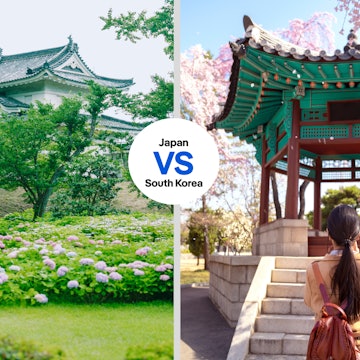
How to get your cell phone connected in South Korea: eSIMs, wi-fi and mobile networks

Apr 7, 2025 • 8 min read

Hwaseong Fortress in Suwon, South Korea. wittaya photo/Shutterstock
South Korea is just about as digital-forward as it gets, with nationwide 4G coverage, ultra-fast networks and widespread wi-fi. Almost anywhere you go, you’ll spot tech-savvy South Koreans, from the very young to the very old, tapping away on their devices, messaging, posting and streaming.
Chances are that while you’re there you’ll also want to get online, to seek out special only-in-Korea experiences and share your precious travel memories. The sheer variety of options can be a bit overwhelming, so here’s our guide for getting connected quickly and easily in South Korea, from roaming and mobile data to eSIMs.
Will my phone work in South Korea?
South Korea’s networks run on UMTS B1 frequency, various LTE frequencies (B1, B3, B5, B7, and B8), and 5G NR (N78 and N257) frequencies. As long as your phone is compatible, which most latest-generation devices are, it should work nationwide.
Make sure to check ahead of time whether your phone is locked into your home network. If it is, you can pay a fee to have it unlocked or opt to purchase a separate secondhand unlocked phone instead.
When choosing how you’ll stay connected in South Korea, consider how much data you plan to use. If you’re simply checking maps, messaging, browsing Instagram and hailing taxis, then 5GB of data should be enough for a week. If you’re hoping to watch videos, you’ll need a lot more, up to 1GB for every hour streamed at standard definition.

What mobile networks are available in South Korea?
South Korea’s major networks are KT, LG U+, and SK Telecom, and the country’s 4G coverage is estimated at 100%, while its 5G coverage is said to reach more than 90% of the population.
It’s simple and straightforward to buy a prepaid plan from a network counter at the airport, a network shop in town, or even some convenience stores. However, if you want to hit the ground running upon touchdown in Korea, you can also purchase your SIM card online in advance, then have it delivered to your home address or ready for pick up at the airport.
Most international providers operate on one or a combination of South Korea’s three main networks, promising widespread coverage. For example, eSIM company Saily primarily uses KT.
How can I get a local SIM card?
To buy a local SIM card for South Korea, all you’ll need is a valid passport. If purchasing online in advance to have the card sent to you – a service offered by some but not all providers – you’ll be asked to input your passport number and possibly also upload photo documentation. The benefit of buying this way is that, if you’re opting for a data and voice plan, you’ll know your local phone number even before you travel to South Korea.
If purchasing or picking up upon arrival, be sure to verify everything is working properly before leaving the sales counter. Also, store your home SIM in a safe place that you’ll remember when you need it again.

Is eSIM available in South Korea and how does it work?
While a traditional SIM is a physical card you can swap in and out, an eSIM (embedded subscriber identity module) is a digital version that can be downloaded to switch between carriers without physically changing cards. You won’t have to worry about misplacing your home SIM, and, depending on the type of eSIM you choose, it can be automatically activated the moment you arrive.
eSIMs offer a few advantages to a physical SIM:
It can be bought anywhere, even before you leave home.
There's no passport, fingerprint or address required.
You can use several carriers and phone numbers at once.
If you run out of data, it's easy to add more.
They're available on some smartphones, tablets and watches.
Before your trip, confirm which type of SIM your phone supports. As a general rule of thumb, these models are eSIM-compatible:
iPhone 11 and onwards
Samsung Galaxy S20 and onwards
Then, provided your device is compatible, consider your eSIM options for South Korea:
Buy through an international provider like Saily, Holafly, Nomad or Airalo which are data-only. Check out our eSIM partner Saily for your next international trip. Made by the team behind NordVPN, Saily’s eSIMs come with added security features like the ability to change your virtual location, block phishing websites, and limit trackers. In South Korea, rates start at US$3.79 for 1GB for 7 days, and US$18.99 for 10GB for 30 days. Use code LP5 to receive 5% off your Saily mobile data plan.
Buy through a local network like LG U+, KT or SK Telecom. These offer data-only eSIMs, which can be purchased online in advance, as well as data and voice eSIMs that come with a local telephone number, which, for LG U+ and KT, must be purchased on-site after arrival.
Buy through a local network partner like eSIM Korea or Korea SIM, both of which also offer data-only and data plus voice options.
Buy through a travel booking site like the locally founded Trazy (data only and data with voice) or the regional service Klook (data only).

Where can I find reliable wi-fi in South Korea?
As one of the most connected countries on the planet, South Korea makes wi-fi readily available in many public places, with Seoul alone claiming to offer nearly 10,000 free wi-fi hotspots. In major cities across the nation, some places that are likely to have public wi-fi include:
Transit spots like airports, subways, railways, buses and taxis
Cultural centers like museums, libraries and exhibition halls
Shopping areas like traditional markets and malls
Welfare facilities like hospitals and community centers
Urban green spaces like parks and beaches
In addition, most hotels, guesthouses, cafes, restaurants and bars provide wi-fi for their guests.
As with all public wi-fi, it’s best not to use it to access any sensitive personal data and to connect by way of a Virtual Private Network (VPN).
How fast and reliable is the internet?
South Korea ranks 7th in the world, according to the Speedtest Global Index, for its median mobile speeds, with downloads clocking in at 205mbps and uploads at 22mbps. Meanwhile, the country ranks 23rd in the world for its fixed broadband speeds. Among mobile providers, SK Telecom is fastest.
Are there any internet restrictions or censorship laws?
In its Freedom on the Net 2024 report, Freedom House gave South Korea a score of 66/100, or “partly free,” for its Internet Freedom Score. In 2023, the government blocked 220,403 websites, some of which included content protected by international human rights standards, such as coverage critical of the president. Other types of internet content blocked in South Korea include some pro-North Korea activity that praises or sympathizes with the regime, as well as pornography.

Can I stay connected at major tourist sites?
In South Korea, many tourist attractions offer wi-fi, such as, for example, the National Museum of Korea in Seoul and Haeundae Beach in Busan. For attractions in remote areas, however, like sprawling national parks or small towns and villages, you’ll need to rely on your phone data.
Will I encounter language barriers when getting connected?
You shouldn’t have any problem communicating with network sales staff, especially at Incheon International Airport and in major cities, who are well accustomed to interacting with foreign tourists. If you need any interpretation assistance, call the Korea Travel Hotline at 1330. Or, if you want an even more streamlined experience, buy your SIM or eSIM online in advance. All the major providers offer English-language websites.
How much does it cost to stay connected in South Korea?
Depending on your particular home phone plan’s international data and roaming rates, connecting in South Korea may be expensive. Verizon, for example, prices pay-as-you-go data at US$2.05/mb, and unlimited data at US$12/day or US$100/month. Mint Mobile charges US$5/day, US$10 for 3 days or US$20 for 10 days.
Usually, it’s more cost-effective to go the SIM or eSIM route, either by way of a local Korean carrier or an international provider. Data-only plans from local providers start at ₩6500 (US$4.43) for 24 hours, while data-only plans from international companies like Saily start at US$3.79 for 1GB for 7 days. Another option is to rent a wi-fi egg (pocket wi-fi hot spot), starting at about US$3/day.

What local tech customs or etiquette should I be aware of?
South Koreans answer calls with “yeoboseyo,” a greeting that’s only used for phone conversations, not in-person conversations. If the caller’s name shows up on caller ID, and they are younger than the receiver, then the call can be answered with a more casual “nae” (yes).
Throughout the conversation, it’s common for listeners to frequently interject with “nae” or “uh” – don’t mistake this as a rude interruption, it’s rather an indication that they are listening. It’s also common to hang up with an elongated “naeeee.” If you are younger than the caller, you should wait for them to hang up first.
When calling in public spaces like trains and subways, speak softly or consider communicating by text instead.
How do I contact emergency services if needed?
In an emergency, call:
112 for police
119 for fire and ambulance
1339 for infectious disease
Stay prepared by downloading useful apps ahead of time for offline access:
NAVER Map and KakaoMap for navigation (currently, due to data laws, Google and Apple maps are less useful in South Korea)
KakaoTalk (more commonly used than WhatsApp)
Kakao T (the most popular ride-hailing app)
Papago for translation
This article was produced by Lonely Planet as part of our partnership with Saily. Lonely Planet's advice and opinions are solely our own.















